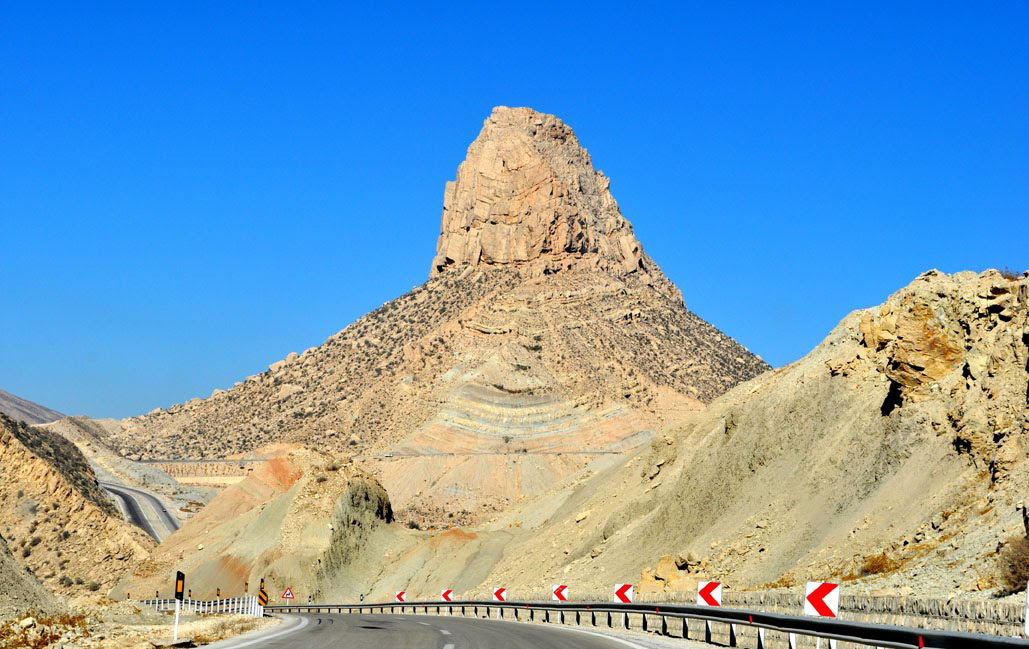In the southern province of Bushehr, the road that links Bandar-Kangan to Firuzabad, runs along a mysterious mountain, locally called Pardis ‘Paradise’, and sometimes referred to as Jam after the county where it is located. Just to confuse matters, the mountain also goes by the name of Padri, literally meaning city guardian.
Mount Pardis, which has a peculiar snout shape, also called Pooz or ‘snout’, has aroused the imagination of many visitors, and given way to superstition. The mountain recently became the focal point of a study undertaken by a UK-based Iranian researcher and archaeologist, Badi’e Dashti who claimed it as the nearest land point to the Sun from the Earth.
Facts
Starting with the tangible facts, Mount Pardis is situated 30km northeast of Siraf, at the southern end of the Zagros mountain range; or from a southerner’s point of view, it is where the Zagros mountain range begins.
Fossils and troglodytic traces point to it as having been agreeable to our ancestors, in the distance past. Pardis juts out like a gemstone against a landscape of low, rolling hills, a mere 700 meters above sea level. Trees and bushes grow abundantly in the mild, humid climate.
There is an astonishing diversity of vegetation in Jam county, among which citruses and dates are famous, especially ‘Khasseh’ dates which are small in size, and sought after as a sweetener by diabetics. The herbs are said to have abundant healing properties; especially those growing near the waters darting up beneath Pardis.
Southern Iran has a hostile climate for olive trees, but to the bemusement of scientists, olive trees thrive to the north of Mount Pardis.
The region is famous for a very special kind of honey. Thanks to the special local thorn bushes, the bees produce a fragrant honey, famous for its tranquilizing and anti-inflammatory effects.
Myth
The Avesta (the most ancient scriptures of Zoroastrianism) refers to the region as Var-e Jam-kard, according to Dashti, Mehr News reported. Var-e Jam-Kard is an underground fortress built by mythical king Jam to preserve the best races among god’s creatures. The ancient scriptures tell a tale similar to that of Noah’s Arch in the Abrahamic tradition: “on the evil material world a winter is about to fall, a strong, destructive winter… but the waters shall flood the lands once the snow is melted….Therefore, make an enclosure, and gather together the seeds of small cattle and of great cattle, of men and dogs and birds and red, blazing fires …”
The high land called Jam, Dashti points out, according to mythology, became the refuge of creatures saved from the great flood, the nearest land point to the Sun, and attributed to a mythical king who was awarded the epithet of ‘shid’ meaning bright or shining.
In 2005 Dashti wrote a letter to the United Nations to protest against the recognition of Tajikistan as the cradle of the Aryan Civilization: “The discovery that Mount Pardis has been inhabited since the Palaeolithic Age proves that the Aryan civilization emerged from Iran and not Tajikistan,” she said, adding that an underground historical site is located some 50 km from Pardis Mountain where there are remnants of a historical village, and where the columns and collapsed ceilings of ancient structures have been unearthed. The first question that comes to mind is whether this historic village is the very fortress, Var-e Jam-Kart of mythology. Dashti claims the area discovered dates back to at least 20,000 years ago.
And on the summit of Mount Pardis, she found evidence, which she believed, points to the existence of a fire temple.
When in Bushehr, Mount Pardis is worth a visit. Visitors should take heed however, the mountain is said to have a high magnetic frequency. There are reports of passing cars being pulled from a 100 meters distance; the high incidents of road traffic accidents in the area have been attributed to this.


